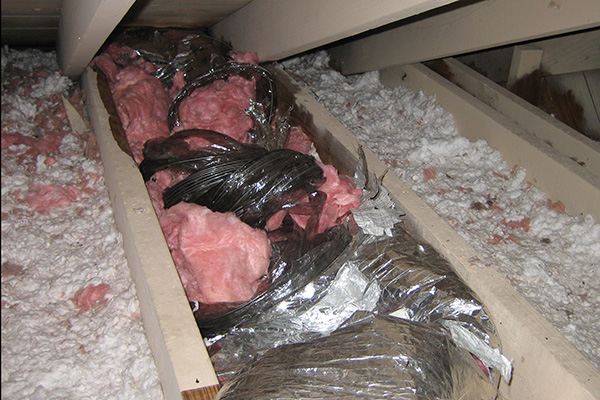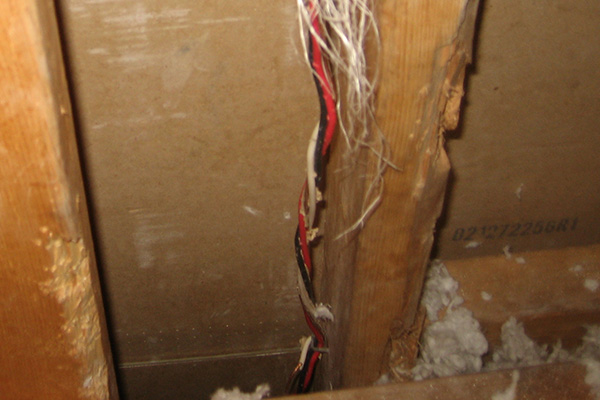- info@animalatticpest.com
- Call - we service 300 locations

Damage Caused By Raccoons in the Attic
Raccoons can cause considerable damage in the attic. The level of damage depends on many factors, such as the length of time the raccoon(s) have been in the attic, the number of raccoons, the presence of electric wires or water pipes or lack thereof, they type of insulation the personality of the raccoons, and so on. This is why a thorough attic inspection is important. If you want to hire someone to do this, and to repair the damage, read more about how much does raccoon removal cost With an attic inspection, can get an understanding of what the raccoons have done, and see specifically what damage they may have caused. Look for areas of trampled down insulation. Look for shredded or torn ducts. Also, I should point out that there'll be external damage, such as torn out soffits, a hole torn through the shingles and roof, or a vent that has been torn out. In the attic, look for chewed wood, and play close attention to electric wires, to see if they have been chewed or shredded and constitute a fire risk. Look for raccoon feces and urine stains, of which there should be a lot! The feces and urine that the raccoons leave behind may cause slight odor problems, but more importantly are a potential source of pathogens or illness. The greatest risk with raccoon droppings in the attic is the raccoond roundworm or Baylisascaris procyonis which can infect people and pets, even if inhaled from disturbed droppings. Don't touch them! It is often a good idea to clean it up, with a full attic restoration. Waste left behind can also encourage the growth of mold, attract bugs like cockroaches, and contains a scent that will encourage new raccoons to enter the attic in the future.
Photographs of Raccoon Damage in the Attic
Torn Air Ducts
I don't know why they sometimes tear up air conditioning or heating ducts. Maybe they want access to cooler air inside! But this is serious damage.
Torn Paper, Insulation, Chewed Wood
There are several types of damage in this photo - wall paper torn off, insulation trampled down to low R-Value, and chewing on the wood beams.
Chewed Electrical Wires
Look closely at this photo (click for larger image). You can see raccoon tracks on the sheetrock around this chewed electrical wire - a potential fire hazard.
Information About Raccoon Damage in the Attic
Damage Caused By Raccoons In The Attic
You probably realize that having a raccoon in your attic will pretty much guarantee that there is damage of some sort. To better be able to handle that damage, however, you need to know what type of issues raccoons are likely to cause. After all, every animal is different and raccoon damage can be very different than damage due to bats or rodents.
Damage To Insulation
Insulation is one of the areas of your attic most likely to be damaged by raccoons. The typical raccoon is between 25 and 30 pounds, meaning that they can trample down insulation in just a few passes. To make matters worse, the majority of raccoons who move into attics or other buildings are pregnant females. They will purposely clear off sections of your attic to make a nest where they can raise their babies. They may compact it on purpose or shred it up to create their preferred shape. Thanks to raccoon damage to your insulation, your home may no longer be able to keep you warm during the winter months or cool during the summer, dramatically increasing your electric bills associated with heating and cooling.
Damage To Wires
When you notice damage to the wires in your attic from raccoons, it will typically be because the animals chewed on them, although they may also scratch these wires. The raccoons are simply looking for things to chew on and wires are an easy target. Sometimes, they may even chew wires to shred them and turn them into nesting material. While other damage that raccoons cause to your attic is costly to repair, issues with the wires can be much more serious. Assuming you are unaware that the wires have been chewed or scratched and they are completely exposed, you have a serious fire risk on your hands. Overloading the wire or even just using it in this case can lead to sparks and start a fire. Since raccoons have already spread you insulation and other items around your attic, there is plenty of kindling. At the very least, chewed wires can lead to malfunctions and will require replacement.
Damage To Ducts
One of the characteristics of raccoon damage in the attic is ducts being ripped apart and even experts aren’t completely sure why they do this. Some think they may rip up ducts in search of nesting material while others speculate that it may simply be fun. The end result is the same regardless of the reason. Your ducts will be damaged beyond repair if you have raccoons in your attic and you will have to replace them or no longer have air flowing through your home.
Damage To Wood
Unfortunately for home owners, raccoons don’t limit their chewing to insulation, wires, and ducts. They will also chew on wood and other items. This means that if you have raccoons in your attic, you will need to carefully inspect all of the wood structures after evicting the animals. In some cases, the raccoons may cause enough damage compromise your attic’s structural integrity so you should never skip a careful inspection.
Torn Paper And Other Items
Realistically, raccoons will tear up or chew on nearly anything they find in your attic, whether it is paper or one of the items mentioned above. Because of this, you may find shredded pieces of newspaper, books, or any other items you had stored in the attic when you go to check on the damage. They have even been known to tear through exterior walls in thinner areas to gain access to the attic. They can also rip through the entire roof, even if there are shingles and wood present.
Leaving Urine And Feces
In addition to damaging items that were already in your attic, raccoons are going to leave their own mess behind in the form of urine and feces. Raccoon feces carry the risk of disease, such as roundworm eggs. These can damage the human nervous system and even cause death if left untreated. Of course, anytime there is raccoon waste in your home, you also have to take the time to clean it up, which can take a long time to do and requires expertise to complete this task thoroughly.
What To Do About The Damage
As mentioned, you should always inspect your attic thoroughly after getting raccoons out because of the range of damage they can cause. You will first need to get all of the raccoons out and seal up the holes that they used as entry points. This is the only way to guarantee more raccoons won’t come inside. Then, you can start cleaning up the mess the animals made, including droppings, food remnants, insulation, and other scraps. Once this is done, you should have a better view of your attic and be able to assess the damage and make appropriate repairs. Don’t forget to sanitize your attic as well.




